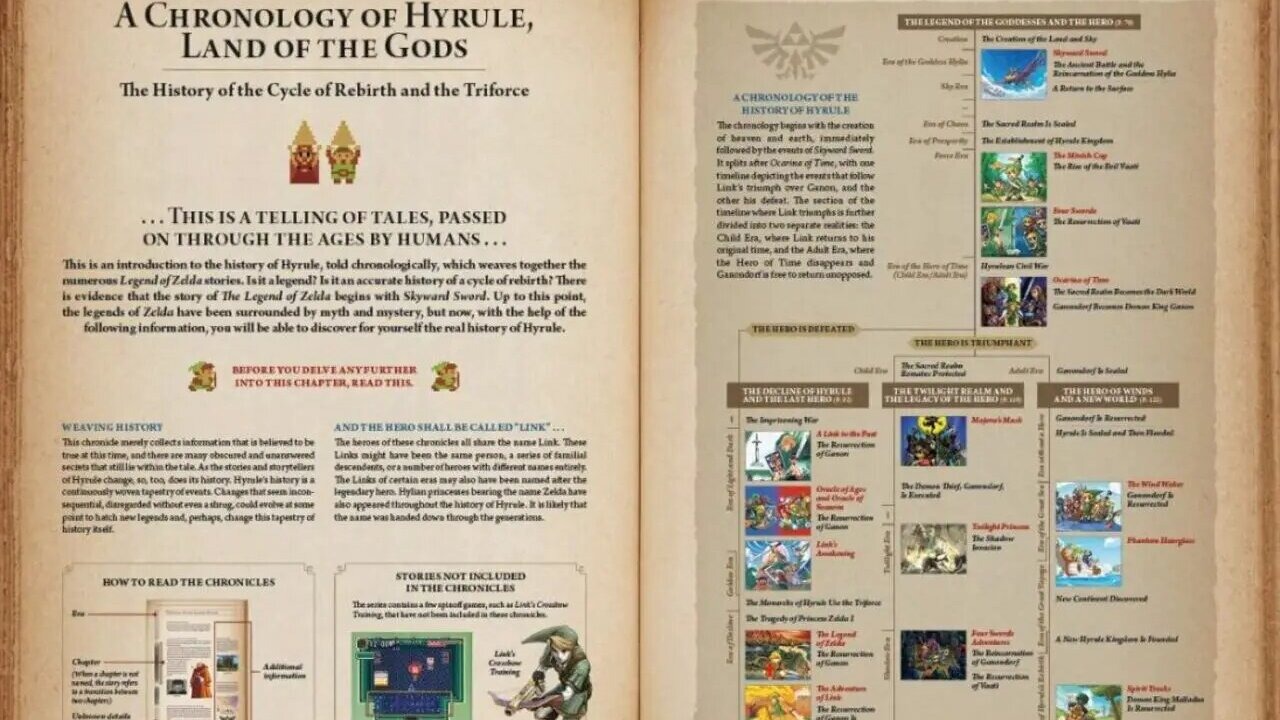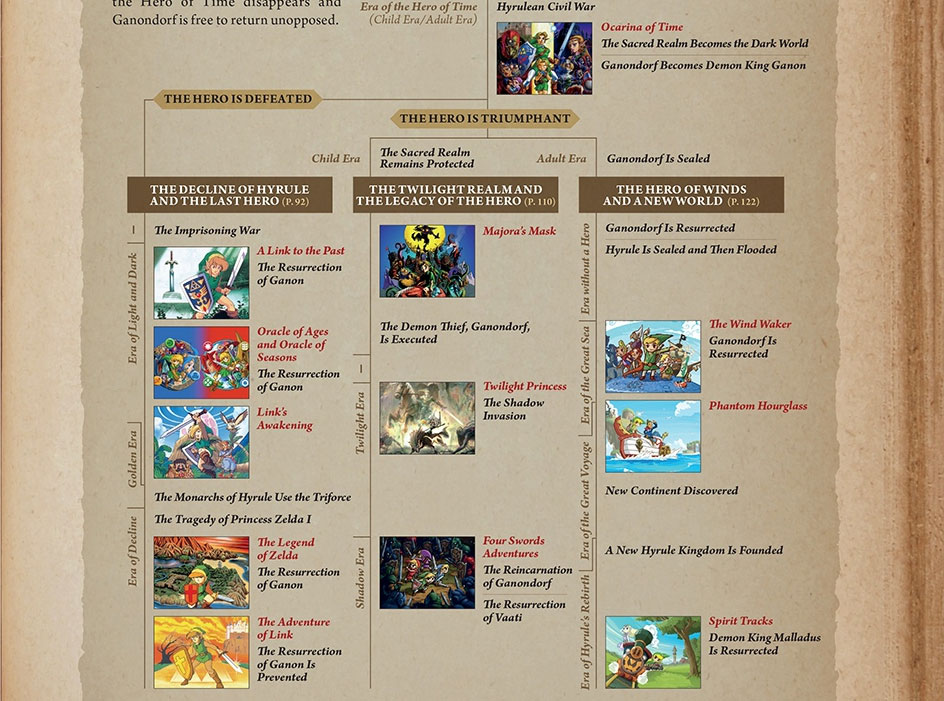Daily Debate: Does the Zelda Timeline Have Value if Developers Treat it as an Afterthought?
Posted on December 19 2023 by Nick Miller

If you were to ask any five Zelda fans what they think about the series’ timeline, you shouldn’t be surprised if you get five completely different answers. To say that the the timeline is a hotly debated subject would be an understatement. Almost as long as The Legend of Zelda has existed, its timeline has been debated, speculated, theorized, and revised. The crux of the whole debate, however, is if there is any value in a timeline at all. Is it worth tying the series down to a timeline that is subject to change? Is it worth asserting a certain chronology when the games’ developers don’t even have consistent opinions on it? Should we prioritize a timeline even when the developers don’t?
Let’s take a brief look through the history of the Zelda timeline, through developer comments and official publications, all the way up through the comments made just last week, to show where some of these inconsistencies lie, where some of these revisions were made, and where Zelda developers currently stand on the matter.
It all started with The Legend of Zelda and Zelda II: The Adventure of Link. Though Zelda II has a somewhat convoluted backstory, it was still a pretty cut and dry sequel to the original game; no question about it. The next entry, A Link to the Past, similarly fit neatly onto the timeline as a prequel to the first two games. The back of the box even makes mention of this by calling the characters of this tale, “the predecessors of Link and Zelda”. Though this presented some confusion as to how Ganon seemingly died at the end of A Link to the Past yet was alive and well in The Legend of Zelda, another game could easily clear this up.

Link’s Awakening came and went, and while it was generally accepted as a sequel to A Link to the Past, the story was largely inconsequential to the overall narrative, so this didn’t cause much of a stir. Then came Ocarina of Time. Developers had made various comments on Ocarina of Time being a prequel to A Link to the Past, though the most controversial of these comments were made by series director Shigeru Miyamoto, whose comments spawned the “Miyamoto Timeline”, or “Miyamoto Order.”
In a 1998 interview for Nintendo Power, he said:
Ocarina of Time is the first story, then the original Legend of Zelda, then Zelda II: The Adventure of Link, and finally A Link to the Past. It’s not very clear where Link’s Awakening fits in — it could be anytime after Ocarina of Time.
Miyamoto placed A Link to the Past after Zelda II. Was this just a bad translation, was this an official change to the timeline, or was it a slip of the tongue? Though fans had largely grown to reject the Miyamoto Timeline, this was still the first major blow to the timeline’s integrity, and it sparked a sentiment that the developers might not care about the series chronology as much as the fans.
Over the next few years, Majora’s Mask and the Oracle games would release without any timeline-related controversy. It wasn’t until a 2002 conference, prior to the release of The Wind Waker, that we would receive one of the more contested pieces of Zelda lore. In an interview, series director Eiji Aonuma said:
Ocarina of Time basically has two endings of sorts; one has Link as a child and the other has him as an adult. This game, The Wind Waker, takes place a hundred years after the adult Link defeats Ganon at the end of Ocarina.
This news confirmed that we were no longer working with just one timeline. Majora’s Mask would follow the timeline where the Hero of Time returns to his childhood, while The Wind Waker takes place in the Hyrule that adult Link had left behind. This begged the question then: if Ocarina of Time had previously been established as the start, and it has two endings, which ending did the original games follow?
This question didn’t receive a clear answer until 2011 with the release of Skyward Sword and its companion book, Hyrule Historia. Skyward Sword was advertised as the birth of the series, the prequel of all prequels… and it was. Skyward Sword showed the forging of the Master Sword and set in motion the events that would wrap the series’ primary characters in a never-ending cycle of conflict. Hyrule Historia supported Skyward Sword‘s placement by finally putting an official timeline on paper, with a shocking new revelation that, contrary to what Aonuma had said previously, Ocarina of Time now had three endings: the two aforementioned endings, as well as one where the Hero of Time dies. The latter is the timeline of the original games. Developers felt they had to create a timeline where the Hero of Time failed to clear up what seemed to be a continuity error in which Ganon ended Ocarina of Time with one piece of the Triforce but began A Link to the Past with the complete Triforce.

While this did clear up a few inconsistencies and put many timeline theories to rest, it presented an inconsistency with Aonuma’s previous comments, which marked another strike against the integrity of the official timeline. It added some fuel to a growing sentiment that chronology was at best a secondary concern to developers, and that the timeline was contrived to appease vocal fans. This wasn’t helped by the release of The Legend of Zelda Encyclopedia in 2017, which reprinted the official timeline from Hyrule Historia with a few alterations. Though the changes were small and relatively insignificant, it was evidence that the timeline was fluid. This caused fans to ask what value a timeline has if it isn’t concrete, if events solidified in lore could be altered or possibly erased with each new game.
After the release of Breath of the Wild in 2017 and Tears of the Kingdom in 2023, both of which were explicitly withheld from the timeline, questions about the official timeline began to resurface. In back-to-back interviews with Game Informer and IGN, Eiji Aonuma and Tears of the Kingdom director Hidemaro Fujibayashi were asked about the series chronology and gave the most definitive comments from developers in recent years.
Aonuma told IGN:
This is a series that really lends itself well to each person playing, then thinking back and interpreting the story elements in their own way… But personally, I don’t like to put too much stock in the chronology of the series, because from the design perspective, that can kind of box us in and limit where we’re able to take the story as we continue making games in the series. And so I do think it’s something that is best for people to interpret on their own.
Fujibayashi said in the Game Informer interview:
We realized that fans have a great time theorizing and enjoy thinking about where things fit on the timeline. That’s something that the development team recognizes and it considers, but to an extent. And I say, “to an extent” because if we get too into the weeds or too detailed in that placement, it results in kind of creating restraints for our creativity; the process of creating new ideas becomes restricted because we’re so tied up and trying to make this fit into a very specific spot in the timeline. We do consider it, but not to an extent where we feel that our development process feels restricted or constrained.
So, while a chronology does exist, these comments undeniably confirm that it’s not a priority to Zelda developers. This isn’t to say they don’t care at all. Fujibayashi acknowledged that they consider it “to an extent,” but they clearly prioritize gameplay and an interesting story above timeline consistency.
As such, it seems that there isn’t much value in an official timeline. There’s just no point in asserting a certain order of events when they could change on a whim. This doesn’t mean, however, that there is no value in theorizing about a timeline. The developers, especially as of late, have repeatedly insisted that they want players to be creative in considering how the events of the games interconnect. Aonuma affirmed this in the Game Informer interview, saying, “The Legend of Zelda is a series of games that focus on puzzle solving, so this is just another sort of puzzle that the users will have to see if they can solve.” So, while it may not be appropriate to insist upon a certain timeline or timeline theory, it would likewise be inappropriate to act like a timeline doesn’t exist in some form, as some games make explicit reference to one another and developers have acknowledged at least a loose consideration for the order of events.
So, what do you think? Is there value in an official Zelda timeline? Do you think conflicting statements from developers hurt the integrity of an official timeline? How do you feel about the recent comments made by developers about the timeline? What are some of your timeline theories? Tell us in the comments!

Nick is a writer for Zelda Dungeon and a longtime fan of the Zelda franchise. In his free time, he enjoys fishing, archery, skateboarding, and some good ol’ fashioned family time. He’s an advocate for physical media and an avid video game collector. His favorite Zelda game is Ocarina of Time, though Breath of the Wild and the Link’s Awakening remake are close contenders.



